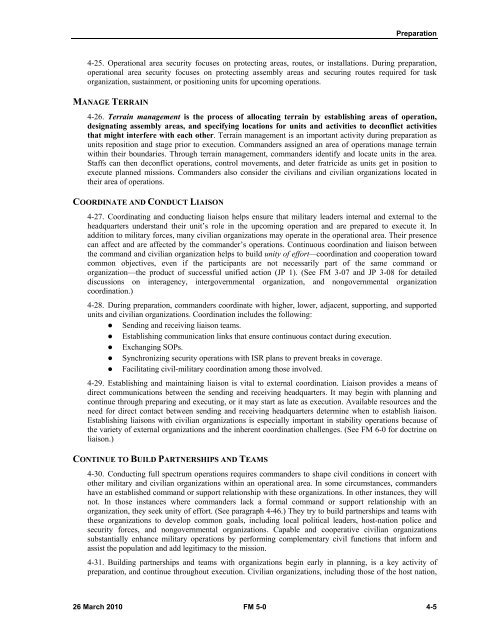FM 5-0, The Operations Process - Federation of American Scientists
FM 5-0, The Operations Process - Federation of American Scientists
FM 5-0, The Operations Process - Federation of American Scientists
You also want an ePaper? Increase the reach of your titles
YUMPU automatically turns print PDFs into web optimized ePapers that Google loves.
Preparation<br />
4-25. Operational area security focuses on protecting areas, routes, or installations. During preparation,<br />
operational area security focuses on protecting assembly areas and securing routes required for task<br />
organization, sustainment, or positioning units for upcoming operations.<br />
MANAGE TERRAIN<br />
4-26. Terrain management is the process <strong>of</strong> allocating terrain by establishing areas <strong>of</strong> operation,<br />
designating assembly areas, and specifying locations for units and activities to deconflict activities<br />
that might interfere with each other. Terrain management is an important activity during preparation as<br />
units reposition and stage prior to execution. Commanders assigned an area <strong>of</strong> operations manage terrain<br />
within their boundaries. Through terrain management, commanders identify and locate units in the area.<br />
Staffs can then deconflict operations, control movements, and deter fratricide as units get in position to<br />
execute planned missions. Commanders also consider the civilians and civilian organizations located in<br />
their area <strong>of</strong> operations.<br />
COORDINATE AND CONDUCT LIAISON<br />
4-27. Coordinating and conducting liaison helps ensure that military leaders internal and external to the<br />
headquarters understand their unit’s role in the upcoming operation and are prepared to execute it. In<br />
addition to military forces, many civilian organizations may operate in the operational area. <strong>The</strong>ir presence<br />
can affect and are affected by the commander’s operations. Continuous coordination and liaison between<br />
the command and civilian organization helps to build unity <strong>of</strong> effort—coordination and cooperation toward<br />
common objectives, even if the participants are not necessarily part <strong>of</strong> the same command or<br />
organization—the product <strong>of</strong> successful unified action (JP 1). (See <strong>FM</strong> 3-07 and JP 3-08 for detailed<br />
discussions on interagency, intergovernmental organization, and nongovernmental organization<br />
coordination.)<br />
4-28. During preparation, commanders coordinate with higher, lower, adjacent, supporting, and supported<br />
units and civilian organizations. Coordination includes the following:<br />
• Sending and receiving liaison teams.<br />
• Establishing communication links that ensure continuous contact during execution.<br />
• Exchanging SOPs.<br />
• Synchronizing security operations with ISR plans to prevent breaks in coverage.<br />
• Facilitating civil-military coordination among those involved.<br />
4-29. Establishing and maintaining liaison is vital to external coordination. Liaison provides a means <strong>of</strong><br />
direct communications between the sending and receiving headquarters. It may begin with planning and<br />
continue through preparing and executing, or it may start as late as execution. Available resources and the<br />
need for direct contact between sending and receiving headquarters determine when to establish liaison.<br />
Establishing liaisons with civilian organizations is especially important in stability operations because <strong>of</strong><br />
the variety <strong>of</strong> external organizations and the inherent coordination challenges. (See <strong>FM</strong> 6-0 for doctrine on<br />
liaison.)<br />
CONTINUE TO BUILD PARTNERSHIPS AND TEAMS<br />
4-30. Conducting full spectrum operations requires commanders to shape civil conditions in concert with<br />
other military and civilian organizations within an operational area. In some circumstances, commanders<br />
have an established command or support relationship with these organizations. In other instances, they will<br />
not. In those instances where commanders lack a formal command or support relationship with an<br />
organization, they seek unity <strong>of</strong> effort. (See paragraph 4-46.) <strong>The</strong>y try to build partnerships and teams with<br />
these organizations to develop common goals, including local political leaders, host-nation police and<br />
security forces, and nongovernmental organizations. Capable and cooperative civilian organizations<br />
substantially enhance military operations by performing complementary civil functions that inform and<br />
assist the population and add legitimacy to the mission.<br />
4-31. Building partnerships and teams with organizations begin early in planning, is a key activity <strong>of</strong><br />
preparation, and continue throughout execution. Civilian organizations, including those <strong>of</strong> the host nation,<br />
26 March 2010 <strong>FM</strong> 5-0 4-5















